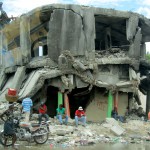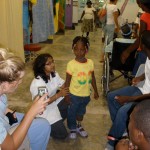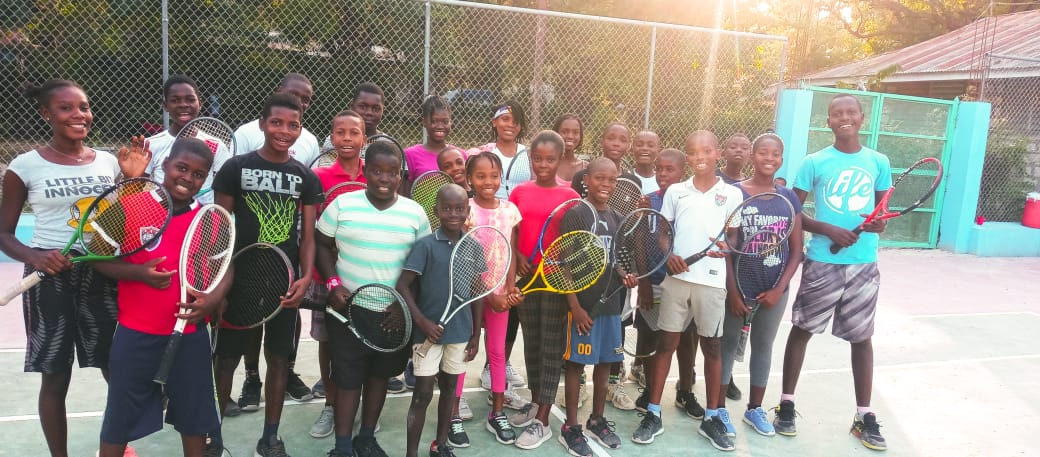
By Daphne Nielsen, 2011.
On Saturday, September 4, 2010, I left Connecticut for a two week volunteer stint at an amputee clinic in Haiti. Prior to going I had gathered as much information as I could on the web, but did not actually know what was in store for me. Doing volunteer work in a needy country had been a dream of mine for many years. I remember being inspired by an article about the hospital ship, Hope, which I had read as a child. My friend, Jenifer Grant, had spoken to me several times about the Hopital Albert Schweitzer (HAS) which had been founded in Deschapelle, Haiti in 1956 by her mother and stepfather, Dr. and Mrs. Lorimer Mellon.

Following the earthquake in Haiti in January of 2010, the Hanger Prosthetics Company, through their Ivan Sabel Foundation, founded a clinic at the hospital in Deschapelle to donate prosthetics to the many victims who lost limbs. Jenifer shared with me the great need for physical therapists to teach the clients to walk on their new legs. Once I made contact the wheels turned very quickly and I was on my way with the gift of a ticket from an organization called Physicians for Peace. Deschapelle is located about 70 miles north of Port au Prince in an area that was not affected by the earthquake.
On my first day in Haiti, which was a Sunday, I was invited to go on a home visit to see the living conditions of a fairly typical Haitian family. Our goal was to assess the needs of a quadriplegic patient who was being cared for at home by her family. The young woman was in her early twenties with a partner and a young daughter and had been injured months earlier in a motor vehicle accident. She had been sent home the day after the accident in spite of her broken neck. In Haiti there is, most likely, no good outcome to a patient with her level of injury and patients are sometimes sent home to die with family. Her family took her back to the hospital after several days and she was airlifted to another hospital where she underwent an unsuccessful stabilization of her neck followed by extensive rehab primarily to teach her extended family how to take care of her. She had made a number of phone calls to her previous PT in Port au Prince to say that she was not doing well at home and wanted to return to the hospital. The rehab coordinator from HAS was joined by a PT who had treated the client in Port au Prince, myself, and the other PT who was working in the Hanger Clinic. The family lived in two small earthen huts with dirt floors and corrugated metal roofs. There were no windows, only a door and a space between the walls and roof to let a little light into the sleeping area. There was no electricity, running water, or screening to keep out flies. The cooking was done over an open fire in the yard and laundry was accomplished in washtubs. There seemed to be many family members who lived in these two very small buildings. The client had a deep, infected sore which needed treatment. She was transferred back to Port au Prince following our visit for further treatment, but the long term prognosis is poor. It was a very sobering look into the reality of life in Haiti.

I began working in the Hanger Clinic the next day. The clinic was staffed by a receptionist, two invaluable translators, five prosthetists, four prosthetic technicians, and two physical therapists. The head prosthetist will stay in Haiti for three months while the other prosthetists and the PT’s mostly come for two week periods.

I worked with another PT from Virginia the first week and one from England the second week. The Haitian people speak Kreyol which is similar to French. My long ago French lessons came in handy, though I was at sea when I got an answer to most of my questions!

Most of our clients came from Port au Prince and had been casted for their leg or legs a week prior to arriving for treatment. This delay allowed the workshop to fabricate the limbs so that they were ready to be fitted on arrival. While receiving PT and adjustments the clients are housed close by

I had been told that the clients I would see were primarily young and healthy and that I would be surprised by how quickly they adapted to their prosthetics. Surprised does not begin to cover my reaction – awed would be more like it. The Haitian people are incredibly strong both emotionally and physically. I found their resilience in the face of all they have been through truly inspiring. The Hanger Clinic was a very happy place to work as we were able to help people get back on their feet and get on with their lives.

It was wonderful to be able to work so closely with the prosthetists who were on-site to make any needed adjustments so that there was no delay in treatment. Many patients were ready to take their new legs home in three to four days. They worked very hard to get used to wearing their prosthetics, often getting up to try again after I had told them to rest for a while. The clients also critiqued and encouraged each other to succeed. I had one fifteen year old girl with an above the knee amputation who got her new leg and never needed a bit of instruction. She put on the leg, got up, and walked across the room without a cane or crutch and climbed the stairs!

We saw clients from age three to seventy three, the majority of whom were quake victims. The others were accident related and a few were diabetics. There are many motor vehicle accidents in Haiti with multiple people on every motorbike and many TapTaps, all going much too fast for the difficult roads. A TapTap is a sort of bus which is a pick-up truck with seats welded to the truck bed and usually a canopy to keep out the sun. The whole vehicle is brightly painted in a kalaidescope of colors. One ‘taps’ on the side to get the driver’s attention for getting on and off. If there isn’t any more seating room, people often get on the roof or hang off the side. When there is an accident, a leg that would be saved in our country is often lost due to infection or some other complication. We have all read about the number of people who lost limbs due to gangrene following the quake.

The visiting staff was very well taken care of while at HAS. I was picked up at the airport in Port au Prince on arrival and housed on the campus at HAS. The hospital is sited on an old Standard Fruit plantation and is dotted with beautiful stone cottages that house many of the staff and a pool to cool off in at the end of the days. Over the years HAS has added a great deal of housing for permanent and visiting staff. I lived in Alumni House with visiting doctors and the other PT. We had two wonderful Haitian women who cooked three meals a day for us, did our laundry, and even ironed my scrubs.

In Haiti everything is spicy – even the peanut butter. We ate mostly some type of stew which was delicious but not necessarily recognizable. There were often bone shards from inexpert butchering leading a visiting Swiss doctor to joke that perhaps we were eating roadkill!

The weather in Haiti is unrelentingly HOT and humid. Most people carry a small rag or washcloth with them to wipe the sweat off their faces. Carrying drinking water is a must. The week before I arrived the Hanger Clinic had gotten a huge floor fan which was a favorite of everyone and had a place of honor in our gym. Many afternoons there was a cooling thundershower, some of which were quite spectacular in their fury. The heat returned quickly as soon as the sun came out again.

Coming home after two weeks in Haiti was strange. In many ways I felt like my being there never happened as I quickly felt swallowed up by my everyday life here. I found myself in Stop and Shop two days after I got home thinking about what my clients might feel if confronted with the excess that we have available every day. I felt overwhelmed.

The contrast of the intense poverty there to how we live is enormous. I feel so lucky to have been able to go to Haiti and help a tiny bit. As I think is usual with this kind of work, I got so much more out of it than I was able to give. I hope to be able to go back to HAS in the future and continue to develop a bond with the people of Haiti.
To learn more about the good work of Hospital Albert Schweitzer, please click here.
Daphne Nielsen, an Essex resident, worked at the Hanger Clinic, a prosthetics facility at Hospital Albert Schweitzer in September 2010. Daphne is a physical therapist in Connecticut.

